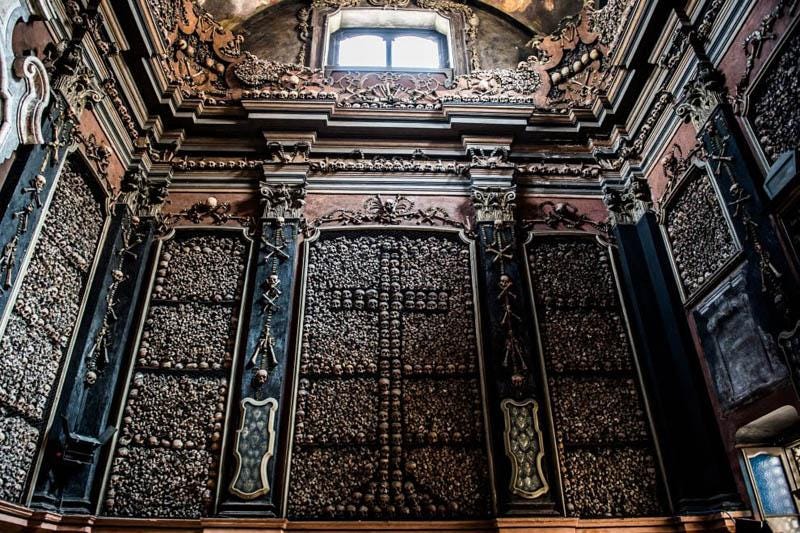Free pirate funerals, crystal coffins and bones with chopsticks
ways of thinking death. [day of the dead special]
In 1950, Pope Pius XII officially declared that Jesus’s mum had ascended into heaven, skipping death altogether. The story had started circulating in some form since the Council of Chalcedon in 451, and it kind of generalized the idea that holy people and saints would not decompose like the rest of us. Corpses smelling like roses and looking like sleeping beauties became part of the imaginary.
Tradition wants that Thomas à Kempis, a holy monk author of “The Imitation of Christ,” dead in odor of sanctity, was exhumed some 200 years after his death to perorate his canonization cause. Unfortunately, the cause could not be brought forward as nail scratch marks on the interior of his coffin lid were found. Apparently, one day, at the venerable age of 90 years old, Thomas fell asleep and was perhaps buried still alive by mistake. The whole point is, he did not die peacefully – so no peace, no sanctity. And of course, that makes sense. One would expect saints to die as nonchalantly as possible, given what they think will happen once they die – kind of like jihadists.
You know who else would like to learn how to die as nonchalantly as possible? A lot of guys into personal growth, possibly muscle development, and/or nutritional supplements. They started carrying a skull coin that says “Memento Mori,” courtesy of the austere daily stoic Ryan Holiday1’s online shop. I think it’s great to remind yourself of your finitude all the time, but if it were up to me, I would lose that coin within 10 days. Okay, fine, 5 days realistically. Oh well, at least I have a very worn copy of Marcus Aurelius’s "Meditations" on my bookshelf. I hope Ryan can still be proud of me.
And of course, speaking of memento mori, every year in the catholic church we have Ash Wednesday, when you’re reminded that “pulvis es, et in pulverem reverteris” (dust you are and to dust you shall return.2). In Milan the church of San Bernardino alle ossa takes the memento mori to the next level. Next level as in the final level of Tekken Tag Tournament with the ghost sparkly blue lady to be precise. They have an entire wall and a lot of decorative details made of simply human skulls.
In Palermo’s Cappuccini Catacomb, an effort has been made to at least keep the skulls where they used to be, that is, on dressed-up mummified corpses propped up to stand in line next to each other as they were still alive. Among all those people in less than their optimal shape, the crystal coffin of the little Rosalia Lombardo is completely distinct. She was only 2 years old when she died and was embalmed by Alfredo Salafia in 1920, looking like an eerie sleeping doll, showing no signs of decay.
Recently, the story of young Carlo Acutis became known to the public because of his canonization cause, which fortunately doesn’t look like it will end up like Thomas’. Carlo tragically died at 15 years old of leukemia. His faith story is quite touching and inspiring. For some reason, when his body got exhumed, it got displayed in a crystal coffin for a while. The church admitted that “minimal” embalming had been done on his face.
Before you say “Ah, Catholics!”, let me tell you it’s not just a Catholic thing. Americans have been obsessed with embalming for a long time. As Caitlin Doughty of Ask a Mortician explains, a lot of people have been misled into thinking that embalming is the only hygienic thing to do and that it is mandatory by law. But misled people aside, a lot of Americans simply want the dead body of their beloved to look fantastic and fresh for weeks. Makeup and nail polish are applied, and the mouth is sewn shut from the inside.
As we learned from the recent news of the nightclub party with the corpse of rapper Goonew that shocked all the prudes, Latino and Black communities also love a less traditional embalming. The dead body is usually propped up in a situation the deceased would have appreciated, such as a drinking night, riding a motorbike, or, well, a nightclub party.
You know who needed embalming in order to simply be able to go back home intact? (Vice)Admiral Horatio Nelson, who died at sea in the south of Spain during the Battle of Trafalgar and got transported back to Great Britain immersed in a cask of brandy mixed with camphor and myrrh.
on the other side of the globe someone else had the urge to preserve holy dead people. until 1879, some buddhist monks in japan would practice “sokushin-jōbutsu”, 即(そく)身(み)仏(ふつ). the monks would progressively change their diet, reduce the intake of liquids and starve themselves in order to die during a mummification process that would start while they were still alive. i found out about this practice thanks to the black and white photographs of aito masatoshi (内藤正敏) from 1966 displayed by michael hoppen gallery called 「即(そく)身(み)物(ぶつ)」. now the practice is illegal in japan but it still happens in other parts of south east asia.
In the Buddhist tradition, dead bodies are cremated, and the remaining bones are picked up by the closest relatives with chopsticks to be put into the urn, starting from the feet end and ending with the head so that they are not buried upside down. That’s understandable: if you died, you are already not doing great; imagine not doing great upside down?
When I was a kid, I was always watching Disney's Peter Pan. I loved the many cheerful songs and the two mistreated old man figures symbolizing power and authority mocked by the new generation, that is Mr. George (“Poor Nana, but poor father?”) and the legendary Captain Hook. Only once I grew up did I realize that that song that goes like “What makes the red man red” was not that funny after all… Oh, sorry, that’s another story. Okay, let’s try again. Only once I grew up did I realize that the Italian version of “A Pirate's Life” song was an absolute existential masterpiece.
“What a lovely job the filibuster has, he does not pay for his funeral. If he kicks the bucket once boredom has occurred he ends up in the depths of the sea, soaking in water forever.”
Among all these ways of thinking about death, this is somehow the most poetic for me.
Happy día de los muertos!
Ryan Holiday’s website is called the Daily Stoic.
Gn 3:19 (Jerusalem Bible)









